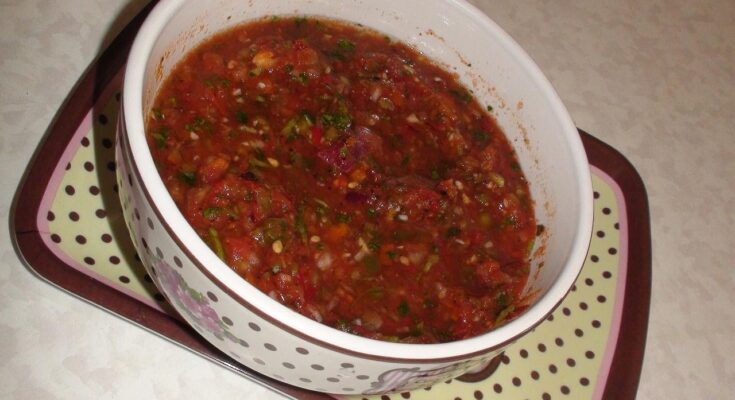Easy Salsa Recipe: Let’s face it—store-bought salsa just can’t compete with the fresh, vibrant flavor of something you whip up in your own kitchen. Homemade salsa isn’t just tastier; it’s also healthier, customizable, and honestly, it’s kind of fun to make. Whether you’re a kitchen newbie or a seasoned home chef, this guide will walk you through everything you need to create the perfect salsa that’ll make your chips dance with joy.
Why Make Salsa at Home?
So, what’s the big deal about making salsa at home? First off, you know exactly what’s going into it. No preservatives, no mystery sugars, no artificial nonsense—just real, whole ingredients. It’s also a money-saver. For the price of one jar of store-bought salsa, you can whip up a whole batch that tastes ten times better. And let’s not forget, it’s quick—seriously, you can have this on the table in under 10 minutes. Pretty awesome, right?
Another perk? You control the flavor. Like it spicy? Add more jalapeño. Prefer it sweet? Toss in some mango. The flexibility is endless. Homemade salsa is a blank canvas, and your taste buds are the artist.
Benefits of Fresh Salsa
Fresh salsa isn’t just delicious—it’s loaded with health benefits too. Tomatoes bring in antioxidants like lycopene. Garlic and onions have immune-boosting properties. And cilantro? It’s like nature’s detox herb. Plus, there’s no added sugar or extra sodium like in those shelf-stable jars.
Eating fresh salsa is an easy way to sneak more veggies into your diet. Serve it with grilled chicken, tacos, or just scoop it up with tortilla chips. You’ll be feeding your cravings and your body at the same time.
Essential Ingredients for Salsa
Before you start tossing things into the blender, let’s go over what you’ll need. A great salsa starts with great ingredients. Here’s the basic lineup for a classic tomato-based salsa:
Core Ingredients Explained
- Tomatoes – Go for Roma or plum tomatoes. They’re meaty and not too watery.
- Onions – White or red onions both work. Red adds a bit more sweetness.
- Garlic – Just a clove or two adds depth.
- Jalapeños – Adjust to your spice preference.
- Cilantro – Gives that unmistakable fresh salsa flavor.
- Lime Juice – Adds brightness and balances the flavors.
- Salt & Pepper – Don’t skip this; seasoning is key!
Optional Add-ons for Extra Flavor
- Avocado – For a creamy twist.
- Mango or Pineapple – For a sweet and spicy flavor combo.
- Cumin – Adds an earthy depth.
- Roasted Peppers – For a smoky hit.
You can mix and match depending on what vibe you’re going for. Want a fruitier salsa? Mango and red onion are your best friends. Want it smoky? Roast your tomatoes and peppers before blending.
Tools You’ll Need
Good news: you don’t need fancy equipment. Here’s what’ll help:
- Cutting board and sharp knife
- Blender or food processor (for smooth salsa)
- Bowl and spoon (for mixing and tasting)
- Citrus juicer (optional but helpful)
That’s it! Simple tools, big flavor.
Step-by-Step Instructions
Time to get into the action. Here’s how to make fresh salsa from scratch in just a few easy steps:
Step 1 – Prepping Your Ingredients
Wash all your produce thoroughly. Dice your tomatoes, chop your onions, mince the garlic, and slice your jalapeños (remove seeds if you prefer less heat). Rough chop your cilantro. Don’t worry about perfect cuts—especially if you’re using a blender.
Step 2 – Blending or Chopping
This step depends on your texture preference. If you like a smooth salsa, throw everything into a blender or food processor and pulse until it’s the consistency you want.
If you like it chunky, skip the blender. Just chop everything finely by hand and stir it all together. Either way, the flavor will be amazing.
Step 3 – Adjusting Seasonings
Taste your salsa. Need more kick? Add another jalapeño. Too sharp? A pinch of sugar can balance the acidity. Not enough zing? Add more lime. This is where you make it your own. Give it a good stir and let it sit for a few minutes so the flavors can mingle.
Fresh vs. Cooked Salsa – What’s the Difference?
When it comes to salsa, you’ve got two main routes: fresh (also known as raw or “cruda”) and cooked. Both are delicious in their own right, but they offer completely different vibes.
Fresh salsa is vibrant, bright, and crisp. It usually involves raw tomatoes, onions, peppers, and herbs, blended or chopped together. This is the salsa you’ll want when you’re in the mood for something refreshing, perfect for hot summer days or when serving with light snacks like chips and guacamole. It’s also super fast to make—no cooking involved means it’s ready in minutes.
Cooked salsa, on the other hand, is deeper in flavor. Think restaurant-style salsa that’s slightly sweet, rich, and more mellow in spice. Cooking the tomatoes and peppers brings out their natural sugars and adds a smoky depth, especially if they’re roasted beforehand. This type of salsa is amazing with tacos, grilled meats, or poured over enchiladas.
Want the best of both worlds? You can blend raw ingredients with some roasted ones to get that perfect balance of fresh and savory.
Salsa Variations to Try
One of the best things about salsa is how many different kinds there are. Once you’ve mastered the basic tomato salsa, you’ll want to try some of these flavorful variations:
Pico de Gallo
Also called salsa fresca, this is a chunkier, raw version of salsa. Instead of blending, everything is chopped into small, even pieces. The texture is crisp, and the flavors are bold. Typically made with tomatoes, onions, jalapeños, cilantro, and lime juice, it’s ideal for topping tacos or spooning over grilled fish.
Salsa Verde
Green salsa? Yep, and it’s amazing. Made from tomatillos instead of tomatoes, this salsa has a tart, tangy flavor that’s totally unique. Roast the tomatillos, blend with garlic, onion, jalapeños, and cilantro, and you’ve got a gorgeous green sauce that pairs beautifully with chicken or tortilla chips.
Roasted Tomato Salsa
This variation takes your classic salsa and cranks it up a notch. Roast your tomatoes, garlic, onion, and chili peppers in the oven until they’re slightly charred. Blend it all together and you’ve got a rich, smoky salsa that’s absolutely irresistible. It’s a little more work, but 100% worth it.
Tips for the Best Homemade Salsa
If you want your salsa to really shine, here are a few tried-and-true tips:
- Use ripe tomatoes – Overripe is actually better than underripe. The flavor will be sweeter and more intense.
- Don’t over-blend – Unless you’re going for a smooth sauce, pulsing a few times is enough. You want some texture.
- Let it rest – Give your salsa at least 15–20 minutes to sit after making it. This allows the flavors to meld.
- Adjust for acidity – If your salsa tastes too tart, a pinch of sugar can work wonders.
- Spice it up smart – Always start with a little chili and add more as needed. You can add heat, but you can’t take it out.
- Experiment with herbs – Cilantro is classic, but fresh basil or parsley can bring a new twist.
- Add a splash of vinegar – A tiny bit of apple cider or red wine vinegar can add a nice zing.
Homemade salsa is all about finding that balance of sweet, spicy, salty, and tangy—don’t be afraid to tweak and taste.
Storing Your Salsa
So, you’ve made a big batch. Now what? Luckily, salsa stores pretty well.
- Fridge: Fresh salsa should be stored in an airtight container and will last 4–5 days. The flavor actually improves after the first day.
- Freezer: Want to keep it longer? Go ahead and freeze it. It’ll keep for up to 2 months, but the texture might change slightly when thawed—best for cooked salsas.
- Canning: If you’re really serious, you can water-bath can your salsa for long-term shelf storage. Just make sure to follow safe canning practices.
Always use a clean spoon to serve it, and if it starts smelling funky or looking slimy, toss it out. Freshness is key when it comes to salsa.
Common Mistakes to Avoid
Even a simple recipe like salsa can go sideways if you’re not careful. Here are a few common slip-ups:
- Using unripe tomatoes – They’ll make your salsa bland and watery.
- Over-blending – You’re making salsa, not soup.
- Too much lime juice – A little goes a long way. Too much can overpower everything.
- Not salting properly – Under-seasoned salsa is a sad thing. Salt brings out all the other flavors.
- Adding hot peppers without tasting – Always taste your chili peppers first. Some are way hotter than others.
- Skipping the rest time – Let your salsa sit so those flavors can get to know each other.
Avoid these pitfalls and you’ll be scooping up award-worthy salsa in no time.
FAQs about Easy Salsa Recipe
Q1: How long does homemade salsa last in the fridge?
Homemade salsa typically lasts up to 5-7 days in the refrigerator when stored in an airtight container.
Q2: Can I freeze salsa?
Yes, you can! For best results, freeze salsa in a sealed freezer-safe container. Note that the texture may change slightly after thawing.
Q3: What tomatoes are best for salsa?
Roma tomatoes or plum tomatoes are ideal because they’re firm and have less water content, making your salsa less runny.
Q4: Can I make salsa without a food processor?
Absolutely. You can finely chop all the ingredients by hand or use a blender for a smoother texture.
Q5: How do I make my salsa spicier?
To turn up the heat, add more jalapeños or serrano peppers, or leave the seeds in. You can also mix in a dash of cayenne pepper.
Q6: Is salsa healthy?
Yes! Salsa is generally low in calories and packed with vitamins, antioxidants, and fiber, especially when it’s homemade.
Q7: Can I use canned tomatoes for salsa?
Definitely. Canned tomatoes are convenient and still delicious—just be sure to drain excess liquid for the right consistency.
Q8: How can I fix salsa that’s too watery?
Strain the salsa using a mesh sieve or add more solid ingredients like chopped onions or peppers to balance it out.
Conclusion
There you have it—your go-to guide for crafting the ultimate homemade salsa. Whether you’re going for a quick snack or leveling up taco night, this recipe is a total game-changer. The beauty of salsa is its simplicity. With just a few fresh ingredients and a bit of personal flair, you can whip up something that’s bursting with flavor and tailored exactly to your taste buds.
From the zesty brightness of lime to the fiery punch of jalapeño, every bite of homemade salsa delivers a delicious punch. It’s not just about dipping chips—salsa brings meals to life. Use it as a marinade, a salad dressing, or even a topper for scrambled eggs. The possibilities are endless, and once you start making your own, you might never buy a jar again.
So next time you’re craving that bold, tangy, spicy kick, skip the store. Head to your kitchen, grab some fresh ingredients, and make a batch of salsa that’s all you. Your taste buds will thank you—and so will everyone you share it with.



